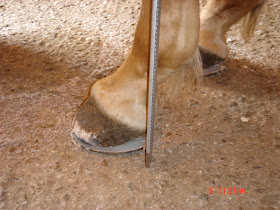Would you hire a carpenter that never used a measuring tape, a level, or a square?
The following are 3 tools your farrier should be using. I've been at this for 30 years, regularly deal with difficult cases, and yet with every horse, every foot, every time, I measure with all three of these tools.
1. Caliper
2. hoof guage,
3. T-square
1. Caliper
Used to measure the toe length. Both front feet should be the same and both back feet should be the same. Although the fronts may be different than the backs.
Why? Well think of it it this way. On your own two feet, if you were wearing a shoe that fit and one that was longer on the other foot not only would it be annoying but it would bother your walking and eventually make you sore. It's the same for your horse.
Also, in a horse, a 1/4 inch of toe-length can make a 5 degree difference in the angle. An 1/8 inch can make a 2 1/2 degree difference. Do you think your farrier can eyeball an eighth of an inch? For us, that might be like wearing a flat shoe and one with a one inch heal. We won't be performing our best so how can we expect a horse to, whose angles are affected by his toe-length. More on angles in Part 2: The Angle Guage.

















































